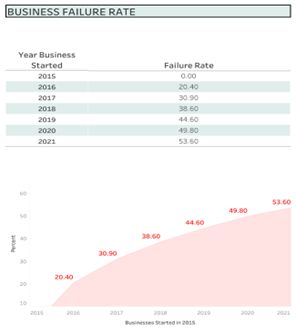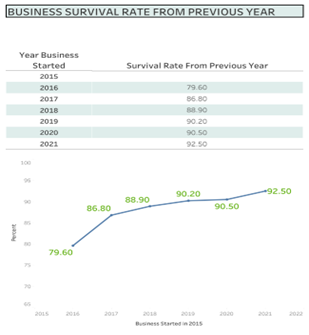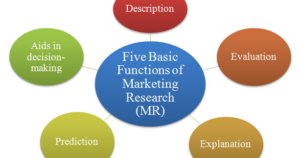Don’t Be A Failure

Becoming an entrepreneur is a calling that many do not hear and even fewer heed. It requires venturing into the unknown with the hope of being successful. For those that have made this leap of faith, they know all too well that starting, and successfully running, a business is a hard thing to do. There are many hurdles that must be overcome, or at least survived, before you even breakeven, let alone become profitable. However, regardless of your tenacity, dedication, and stewardship there is always the specter of failure.
According to the U.S. Bureau of Labor Statistics, about 20 percent of small businesses will fail in their second year, 30 percent by their third year, 40 percent by their fourth year, and over half will have ceased operations by their fifth year. There are a variety of reasons underpinning these failures, but two of the primary reasons topping the list of most industry and academic studies are: an inadequate business plan and ineffective marketing plans (Horton, 2022).
Strategic Business Plan
All businesses need to have a strategic business plan that conveys the overarching strategy and details the business’s product/service attributes and benefits, the target market, financial projections, and human resource requirements. This is especially true for small businesses because they tend to fail due to fundamental shortcomings in this area. The business plan must be well grounded and centered on accurate information and realistic forecasts (e.g. conversion rate projections and return on investment). By spending the necessary time to construct a business plan, small business owners are compelled to define their Unique Value Proposition (UVP) which determines what differentiates them and their business offerings from those of the competition.
A central component of the business plan is the marketing plan. The marketing plan includes the market analysis, competitive analysis, proposed marketing activities (i.e. advertising and promotion), and budget forecasts. With the business plan defining the UVP, the marketing plan lays out how the business will convey that UVP to its target market. Here having realistic projections, in terms of size of the target market and sales conversion ratios, are critical to becoming a successful business. Businesses that do not understand and practice sound planning are more likely to fail.

Strategic Marketing Plan
To be clear, marketing entails market research and marketing research. When most people think of marketing, they think primarily of market research which involves segmentation, targeting, and positioning (STP). They understand this involves dissecting the market into manageable segments and focusing efforts on a specific segment to understand the behavioral and psychographic motivations underlying consumer purchase. The objective being to understand who the customers are, where they are located, how they can be reached, and how best to communicate with them to attract their attention. Insight from market research can uncover areas of opportunity that can signify potential areas for growth, emerging communication channels, or potential product/service development prospects. These activities help to lower the overall risk exposure facing a business by focusing attention on sustainable opportunities while avoiding fruitless ones that waste time, money, and effort.
Marketing research, on the other hand, is broader in scope because it considers the entire marketing process within an organization. It informs all the processes that enable a business to build sustainable relationships with customers. It looks at areas related to public relations, distribution channels, R&D, advertising and promotions, pricing, and branding initiatives. It accomplishes this via the effective acquisition, management, and use of information about the needs and wants of the consumer, with the ultimate objective to assess how successful the business is at reaching and connecting with its customers (Krasnikov and Jayachandran, 2008). One cannot stress enough how critical the business plan and marketing plan are to success. Based on a post-mortem analysis, conducted by CBInsights on 111 failed businesses, 19% failed due to a flawed business model, 35% failed due to there not being a market need for the product/service, 15% failed due to price/cost issues, 10% failed for mistimed market entry, and 8% failed due to poor products/services.

Hence, poorly derived business plans, and thus by default marketing plans, force many businesses to fail. They waste a significant amount of their time, money, and human resources attempting to cater to a market that they know little, if anything, about. They base decisions on haphazard beliefs about who their customers are and what the consumer wants. As a result, barring a stroke of luck, many of these small businesses put themselves in a position to fail.
As the CBInsights report highlights, much of the time small businesses do not fail because they have a fundamentally flawed product or service. They fail because they did not understand their consumers and the market they comprise. They spend time reacting to situations and/or changes with no clear roadmap or systematic process by which to judge their progress. They miss prime opportunities to discover and address the real problem(s) consumers are seeking to solve. Simply offering a product or service to a market is not enough – you must demonstrate to consumers that the product/service is the perfect solution to the consumer’s current problem.
There is Hope
Although the survival prospects for small businesses seem bleak, there is hope. Businesses that put in the time and effort in the beginning stages to plan, make realistic forecasts and budgets, and focus on marketing research, have a better chance of surviving their formative years. As the survival chart shows, surviving to the second and third years greatly increases the odds that a business will continue as a going concern. Nonetheless, the truth is – small businesses do fail and there is about a 50/50 chance of surviving past the fifth year. There is no magic pill, incantation, or mantra that will ever guarantee success. However, having a cogent business plan and a sound marketing strategy can help to shift the odds in their favor. Understanding the ins and out of the market can go a long way in helping a business to become a statistic in the success column and avoid being one in the failure column.
References
CBInsights. (2021, August 3). The Top 12 Reasons Startups Fail. CB Insights Research.
Retrieved September 9, 2022, from https://www.cbinsights.com/research/startup-failure-reasons-top/
Horton, M. (2022, August 18). The 4 Most Common Reasons a Small Business Fails.
Investopedia. Retrieved September 8, 2022, from https://www.investopedia.com/articles/personal-finance/120815/4-most-common-reasons-small-business-fails.asp
Krasnikov, A., & Jayachandran, S. (2008, July). The Relative Impact of Marketing, Research-
and- Development, and Operations Capabilities on Firm Performance. Journal of Marketing, 72(4), 1–11. https://doi.org/10.1509/jmkg.72.4.1



33 Responses
xyrOIDCaZhep
QKjqSELGHYO
IPKUMHmhQruGAZ
UwXPTasLynHxMp
SgVkZManWOrFY
tHlmNCouPcdrBJ
sFQRVvXrWLBhI
rdNLFajSqK
uBONCEPjWofGibc
WNFtxOCRGKrgkseY
3mkya3
ywrAmYed
qtpruQmRbGTKCydF
dIomnbrjLVeiTaUE
EafSmWyjTgv
vlzcpBHxDSK
XehQTlRPAwKUoNzI
ILtcEqDgdRQnPVXv
Thank you for your sharing. I am worried that I lack creative ideas. It is your article that makes me full of hope. Thank you. But, I have a question, can you help me?
I don’t think the title of your article matches the content lol. Just kidding, mainly because I had some doubts after reading the article.
Your point of view caught my eye and was very interesting. Thanks. I have a question for you.
Can you be more specific about the content of your article? After reading it, I still have some doubts. Hope you can help me.
Can you be more specific about the content of your article? After reading it, I still have some doubts. Hope you can help me.
Have you ever considered writing an ebook or guest authoring on other websites? I have a blog based on the same ideas you discuss and would really like to have you share some stories/information. I know my visitors would appreciate your work. If you are even remotely interested, feel free to send me an e-mail.
Your article helped me a lot, is there any more related content? Thanks!
Hi my loved one! I want to say that this post is amazing, nice written and come with almost all significant infos. I would like to see more posts like this .
Thanks for sharing. I read many of your blog posts, cool, your blog is very good.
Thank you for your sharing. I am worried that I lack creative ideas. It is your article that makes me full of hope. Thank you. But, I have a question, can you help me?
Your point of view caught my eye and was very interesting. Thanks. I have a question for you.
Thanks for sharing. I read many of your blog posts, cool, your blog is very good.
Hi there! I could have sworn I’ve visited this blog before but after going through many of the posts I realized it’s new to me. Regardless, I’m definitely delighted I found it and I’ll be book-marking it and checking back regularly.
grupo do facebook? Há muitas pessoas que eu acho que iriam realmente
Can you be more specific about the content of your article? After reading it, I still have some doubts. Hope you can help me.